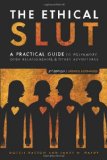I am leading a read-through of The Ethical Slut, 2nd edition. If you’d like to catch up on past installments, check the list at the bottom of the series introduction. Comments on the topics in this discussion are welcome anytime, even from people who aren’t following along in the book.
This week, the read-along continues with a discussion based on CHAPTER 19, “The Single Slut”
For some, polyamory or non-monogamy is a choice made in the context of a specific relationship — such as when a married couple, after communication and negotiation, choose to open up their relationship to new people. For others, polyamory is a lifestyle-choice; these people stay polyamorous even when they are single because they do not ever want monogamy. Poly singles will often date exclusively with other polyamorous or similarly open-minded people. Some will take it a step further and remain single even when they are with others.

The idea that the individual, rather than the couple, are the core unit in polyamory — a concept sometimes called “Network Polyamory” — is the focus of this chapter of The Ethical Slut. Once again, it comes down to conscious choice — for such people, being single is not just a matter of happening to be between relationships, but a conscious choice to keep a certain level of independence regardless of how many sexual or romantic involvements may occur. This choice might last for years — Dossie Easton says she has spent half her adult life single — or it could be more temporary.
“To live single and in love with many is a voyage of self-discovery, an opportunity to get to know yourself intimately and to work on any changes you want to make in your life.” –from The Ethical Slut
At the core of being consciously single is putting yourself first. This is a notion that is often unpopular. True selfishness is rampant — making choices which result in personal gain and reckless loss in others. On the other hand, I believe that when we prioritize ourselves we are then better able to help others. There are times — like when a child or partner is in desperate need — that we must dig deep and give even if it hurts but in general we have to give only as much as we can and know our limits! Putting self first is especially important when we need to focus on personal growth or have a history of martyring ourselves for our lovers.
Taking this route has its risks. You have to be comfortable with the idea of being alone — and of not dating or committing to serious relationships just because you fear loneliness. This is a danger for the monogamous too — Dossie Easton relates how her grandmother’s husband died in their sixties, leaving her with almost three decades of life alone. It also opens up freedoms — from privacy, more available alone time to recharge for introverts or to work for artists, to increased freedom to live in your own way.

I once asked my friend Tea where to find the “cockles of the heart,” and she cleverly retorted, “Just above where the strings attach.” An important point that this chapter makes is that love can come without attachment — you can still share that warm, fuzzy feeling of intimacy with a person without requiring them to move in, get married, have kids, or form other entanglements. Over time, the single poly often creates more serious and involved relationships and might become part of a couple or larger committed group, but that need not be the assumption or the goal.
There are still considerations for others. Every relationship is meaningful, and single polys need to respect the other relationships that intersect just as the coupled or committed need to respect the love that a single poly shares; in this chapter, The Ethical Slut lays out a list of responsibilities for each. In particular, I am sometimes suspicious of “unicorn hunters” — bisexual couples looking to add a third person to a closed, polyfidelitous relationship. Is it disrespectful or unethical for such couples to date a person who has existing connections? Of course, the subject of their attentions has free will too, and in the end must follow his heart and best judgment about whether to join their relationship and leave others.
In my life I have spent many years living this way and, even as I grow closer to Pet and my other relationships, I make sure to meet my needs first — with the hope that they will do the same. Were you single and polyamorous for a while? Maybe circumstance made you single, but pleasure kept you that way? Share your experiences in the comments.
In our next installment, we’ll look at breakups and other endings in Chapter 20, “The Ebb and Flow of Relationships.”